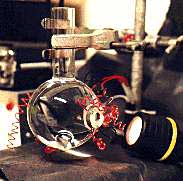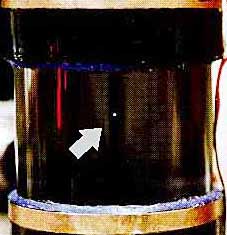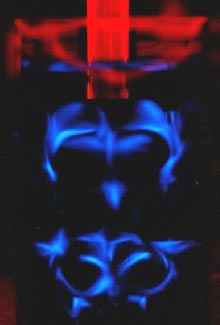Sound, Lights, Action!
About Sonoluminescence!
Sonoluminescence is a way to turn sound energy into light. When intense sound waves are created in a flask of water, a tiny air bubble in the water can give off flashes of light. Despite the simplicity of the experiment, how the light is produced remains controversial.
How to do it

Inexpensive tabletop setup to observe sonoluminescence. The coiled wires lead to transducers that excite the sound waves in the water-filled flask. (photo courtesy of Andrew Steer)
The photo shows the simple apparatus for what is actually an undergraduate lab. A flask is held in a clamp on a ring stand. The coiled wires are connected to two transducers-like small speakers, but operating at a frequency of about 25,000 Hz., just beyond the range of human hearing. The transducers are tuned to make the flask and water resonate, so energy in this system builds up to a high level (like pushing a child on a swing). If a bubble of air is introduced into the flask near the center, it can be trapped there. The intense sound waves first expand the bubble and then collapse it. When the bubble approaches its smallest diameter, about a millionth of a meter, there is a very short, intense flash of light, with the flashes repeating at the frequency of the applied sound waves.
What kind of light?
This is a big part of the mystery. The bubble gives off both visible light and quite a lot of ultraviolet light, which indicates that the gas inside the bubble could be as hot as about 100,000o C. At this temperature, the gas would be ionized, so it would be plasma.
Despite the high maximum temperature of the gas in the bubble, the water does not boil. The gas reaches this temperature for only a short time. Also, the collapsed bubble is very small, about 10-6 m across, so its thermal energy is far less than what would be required to heat the water significantly.
Physicists Disagree

The tiny white spot in the center is the light emitted by the air bubble, which expands and collapses repeatedly, emitting a flash of light with each collapse. (photo courtesy of L. Crum)
Observed bubble compression: By bouncing laser light off the bubble, physicists measure the size of the contracting bubble and then compute its temperature. The observed contraction of the bubble should heat the gas inside to temperatures of about 10,000o C., which is higher than the temperature of the surface of the sun. Many physicists accept this prediction.
Shock wave: Some physicists argue that the collapse of a bubble produces a shock wave, something like the one in a sonic boom but spherically symmetric. The wave crushes the gas in the bubble, heating it up as the wave passes. Then, when the shock wave reaches the center of the bubble and rebounds, it heats the gas again, and in the process can produce temperatures as large as 100,000o C.
Links
American Institute of Physics
- Physics News Preview: The Physics of "Chain Reaction"
- Physics News Update: Has Nuclear Fusion Been Observed in a Bubble Tank?

Multi-bubble sonoluminescence generated in a beaker of water by an acoustic horn (photo courtesy of L. Crum)
Oak Ridge National Laboratory














